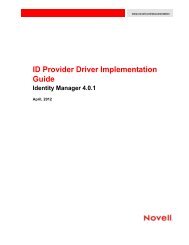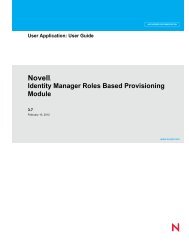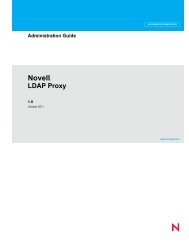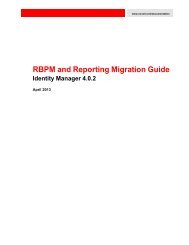Identity Manager 4.0.1 Driver for Scripting Implementation ... - NetIQ
Identity Manager 4.0.1 Driver for Scripting Implementation ... - NetIQ
Identity Manager 4.0.1 Driver for Scripting Implementation ... - NetIQ
Create successful ePaper yourself
Turn your PDF publications into a flip-book with our unique Google optimized e-Paper software.
2Planning <strong>for</strong> the <strong>Scripting</strong> <strong>Driver</strong><br />
2<br />
The planning process <strong>for</strong> the Novell ® <strong>Identity</strong> <strong>Manager</strong> <strong>Driver</strong> <strong>for</strong> <strong>Scripting</strong> begins by determining<br />
whether you develop your own scripts and policies <strong>for</strong> use with your external account management<br />
system or you obtain them from a third party.<br />
If you are customizing the scripts, the process continues by installing the <strong>Scripting</strong> driver to a<br />
development system. The first decision to make is whether you run the driver shim on Windows or a<br />
Linux/UNIX system. (The driver engine component hosted by Novell <strong>Identity</strong> <strong>Manager</strong> can run on<br />
any operating system that supports <strong>Identity</strong> <strong>Manager</strong>.) The driver shim should be installed on a<br />
system that hosts, or is remotely connected to, the external account management system. The<br />
operating system of this system is the operating system of the driver shim.<br />
Your operating system choice determines what scripting language to use. On Linux and UNIX, prewritten<br />
libraries are included <strong>for</strong> Bourne shell, Perl and Python*. On Windows, libraries are<br />
included <strong>for</strong> Microsoft VBScript and PowerShell*. Also, with additional development work, you<br />
can port these libraries to another scripting language.<br />
Continue the development process by reading Chapter 5, “Customizing the <strong>Scripting</strong> <strong>Driver</strong>,” on<br />
page 35 and following its instructions.<br />
If you have obtained custom scripts from a third party, you should follow their instructions <strong>for</strong><br />
installing the <strong>Scripting</strong> driver and their custom components.You should install and test the driver on<br />
a test system first and then on production systems.<br />
This section reviews some of the issues to consider be<strong>for</strong>e you install the <strong>Scripting</strong> driver. Major<br />
topics include<br />
• Section 2.1, “Prerequisites <strong>for</strong> Linux and UNIX <strong>Scripting</strong>,” on page 15<br />
• Section 2.2, “Prerequisites <strong>for</strong> Windows <strong>Scripting</strong>,” on page 16<br />
• Section 2.3, “Establishing a Security-Equivalent User,” on page 17<br />
For general in<strong>for</strong>mation about planning <strong>for</strong> identity management, see the <strong>Identity</strong> <strong>Manager</strong> 3.6.1<br />
Installation Guide.<br />
2.1 Prerequisites <strong>for</strong> Linux and UNIX <strong>Scripting</strong><br />
Topics in this section include<br />
• Section 2.1.1, “<strong>Identity</strong> Vault Server Requirements,” on page 15<br />
• Section 2.1.2, “Supported Operating Systems,” on page 16<br />
• Section 2.1.3, “Other Software,” on page 16<br />
2.1.1 <strong>Identity</strong> Vault Server Requirements<br />
• Novell <strong>Identity</strong> <strong>Manager</strong> 3.5.1.<br />
Planning <strong>for</strong> the <strong>Scripting</strong> <strong>Driver</strong><br />
15
















